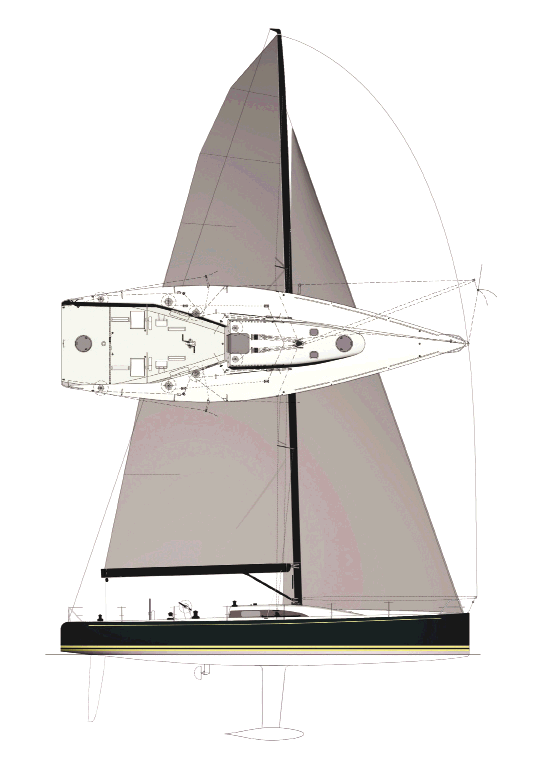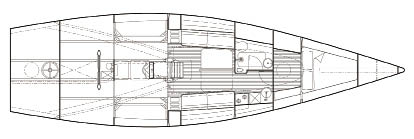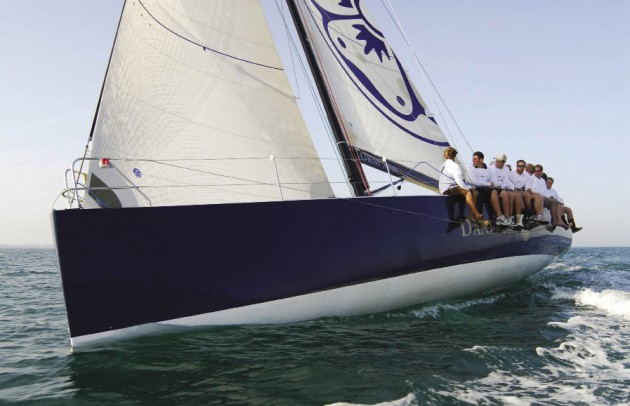Rogers 46
2008 February 6
February 2008
IRC racer
The range of material I get for these reviews is remarkable. I often get pages of specs and very complete drawings packages. Sometimes I get basic dimensions, "artist renderings" and builder's comments that I could best describe as romantic drivel. In the case of this Simon Rogers design I got really nice drawings, some good 3D images, some VPP comparisons for competitive designs, a good selection of photos of the first boat and a fairly complete set of basic specifications. I could have used some romantic drivel. There is nothing in this package to tell me what the boat is for so I am just going to assume it's an all-out IRC racing boat. Given the fact that the first three Rogers 46s are winning just about everything they enter, according to the Web site, this seems a safe assumption.
This boat has a D/L of 82.07, making it a light IRC design. The L/B is 3.5 and that makes it narrower proportionately than most IRC boats-but not by much. As you would expect from any boat with a D/L this low there is very little fore and aft hull rocker. Draft is 9 feet, 6 inches with a T-bulb fin configuration with 6,000 pounds of lead in the bulb. The hull is all carbon wet-preg over a foam core, molded in a female mold and vacuum baked at 65 degrees Celsius. The deck is also carbon but it's built over a male mold. I wonder why? The inside of the deck will have a nice finish but the topside will require fairing, so I don't think there would be a weight savings. Regardless, this is a very fast looking hull.
 This interior layout is all about fulfilling the requirements of the ORC rule. There are berths for eight placed well aft. But this boat will be primarily day raced so when there is no off watch there is very little weight aft. The head and galley are forward where their weight will not hurt performance. There is a V-berth double forward. This is a lightly built interior not intended to provide cruising comfort.
This interior layout is all about fulfilling the requirements of the ORC rule. There are berths for eight placed well aft. But this boat will be primarily day raced so when there is no off watch there is very little weight aft. The head and galley are forward where their weight will not hurt performance. There is a V-berth double forward. This is a lightly built interior not intended to provide cruising comfort.
 The deck is all business and the cockpit takes up about 40 percent of the total deck area. The transom is wide open and similar in layout to a TP 52. The mainsheet traveler is aft and the twin wheels have been pushed forward to keep crew weight out of the stern. Runner winches are the only gear aft of the traveler. Downwind in a breeze, when you need to get the weight aft, there is plenty of room in the back of this bus for the crew to congregate. I'm having a little trouble reconciling the photos of the first boat with the drawings, but I suspect that each of these boats will be semi-custom built and it's to be expected there will be changes in each deck layout. The mainsheet is the German-style and appears to lead from the forward end of the boom under the deck to reappear at the winches aft. The primary winches share a single pedestal. The specs call for a centerline retractable bowsprit but neither the photos nor the drawings show this feature. The short jib tracks give the jib a 7.5-degree sheeting angle. The photos show a center console box on the cockpit sole with numerous lines exiting. This does not show on the drawings. The result is a very clean deck and cockpit layout.
The deck is all business and the cockpit takes up about 40 percent of the total deck area. The transom is wide open and similar in layout to a TP 52. The mainsheet traveler is aft and the twin wheels have been pushed forward to keep crew weight out of the stern. Runner winches are the only gear aft of the traveler. Downwind in a breeze, when you need to get the weight aft, there is plenty of room in the back of this bus for the crew to congregate. I'm having a little trouble reconciling the photos of the first boat with the drawings, but I suspect that each of these boats will be semi-custom built and it's to be expected there will be changes in each deck layout. The mainsheet is the German-style and appears to lead from the forward end of the boom under the deck to reappear at the winches aft. The primary winches share a single pedestal. The specs call for a centerline retractable bowsprit but neither the photos nor the drawings show this feature. The short jib tracks give the jib a 7.5-degree sheeting angle. The photos show a center console box on the cockpit sole with numerous lines exiting. This does not show on the drawings. The result is a very clean deck and cockpit layout.
This rig will get your attention quickly. The SA/D is 32.43. If you need a "seat-of-the-pants" feel for what this means just consider this. The Rogers 46 weighs about half as much as a Valiant 40 and has 36-percent more sail area. The horsepower-per-pound of this speedster is double that of the typical family dual-purpose boat. Do not put your mother-in-law on the wheel for a jibe with the chute up unless you have a weird sense of humor. Spreaders are swept 22 degrees and the roach overlaps the backstay by about 30 inches. The rig is supplied by King Composites of Argentina.
This beautiful boat will provide very exciting around the buoys racing in any fleet.
IRC racer

The range of material I get for these reviews is remarkable. I often get pages of specs and very complete drawings packages. Sometimes I get basic dimensions, "artist renderings" and builder's comments that I could best describe as romantic drivel. In the case of this Simon Rogers design I got really nice drawings, some good 3D images, some VPP comparisons for competitive designs, a good selection of photos of the first boat and a fairly complete set of basic specifications. I could have used some romantic drivel. There is nothing in this package to tell me what the boat is for so I am just going to assume it's an all-out IRC racing boat. Given the fact that the first three Rogers 46s are winning just about everything they enter, according to the Web site, this seems a safe assumption.
This boat has a D/L of 82.07, making it a light IRC design. The L/B is 3.5 and that makes it narrower proportionately than most IRC boats-but not by much. As you would expect from any boat with a D/L this low there is very little fore and aft hull rocker. Draft is 9 feet, 6 inches with a T-bulb fin configuration with 6,000 pounds of lead in the bulb. The hull is all carbon wet-preg over a foam core, molded in a female mold and vacuum baked at 65 degrees Celsius. The deck is also carbon but it's built over a male mold. I wonder why? The inside of the deck will have a nice finish but the topside will require fairing, so I don't think there would be a weight savings. Regardless, this is a very fast looking hull.
 This interior layout is all about fulfilling the requirements of the ORC rule. There are berths for eight placed well aft. But this boat will be primarily day raced so when there is no off watch there is very little weight aft. The head and galley are forward where their weight will not hurt performance. There is a V-berth double forward. This is a lightly built interior not intended to provide cruising comfort.
This interior layout is all about fulfilling the requirements of the ORC rule. There are berths for eight placed well aft. But this boat will be primarily day raced so when there is no off watch there is very little weight aft. The head and galley are forward where their weight will not hurt performance. There is a V-berth double forward. This is a lightly built interior not intended to provide cruising comfort. The deck is all business and the cockpit takes up about 40 percent of the total deck area. The transom is wide open and similar in layout to a TP 52. The mainsheet traveler is aft and the twin wheels have been pushed forward to keep crew weight out of the stern. Runner winches are the only gear aft of the traveler. Downwind in a breeze, when you need to get the weight aft, there is plenty of room in the back of this bus for the crew to congregate. I'm having a little trouble reconciling the photos of the first boat with the drawings, but I suspect that each of these boats will be semi-custom built and it's to be expected there will be changes in each deck layout. The mainsheet is the German-style and appears to lead from the forward end of the boom under the deck to reappear at the winches aft. The primary winches share a single pedestal. The specs call for a centerline retractable bowsprit but neither the photos nor the drawings show this feature. The short jib tracks give the jib a 7.5-degree sheeting angle. The photos show a center console box on the cockpit sole with numerous lines exiting. This does not show on the drawings. The result is a very clean deck and cockpit layout.
The deck is all business and the cockpit takes up about 40 percent of the total deck area. The transom is wide open and similar in layout to a TP 52. The mainsheet traveler is aft and the twin wheels have been pushed forward to keep crew weight out of the stern. Runner winches are the only gear aft of the traveler. Downwind in a breeze, when you need to get the weight aft, there is plenty of room in the back of this bus for the crew to congregate. I'm having a little trouble reconciling the photos of the first boat with the drawings, but I suspect that each of these boats will be semi-custom built and it's to be expected there will be changes in each deck layout. The mainsheet is the German-style and appears to lead from the forward end of the boom under the deck to reappear at the winches aft. The primary winches share a single pedestal. The specs call for a centerline retractable bowsprit but neither the photos nor the drawings show this feature. The short jib tracks give the jib a 7.5-degree sheeting angle. The photos show a center console box on the cockpit sole with numerous lines exiting. This does not show on the drawings. The result is a very clean deck and cockpit layout.This rig will get your attention quickly. The SA/D is 32.43. If you need a "seat-of-the-pants" feel for what this means just consider this. The Rogers 46 weighs about half as much as a Valiant 40 and has 36-percent more sail area. The horsepower-per-pound of this speedster is double that of the typical family dual-purpose boat. Do not put your mother-in-law on the wheel for a jibe with the chute up unless you have a weird sense of humor. Spreaders are swept 22 degrees and the roach overlaps the backstay by about 30 inches. The rig is supplied by King Composites of Argentina.
This beautiful boat will provide very exciting around the buoys racing in any fleet.

Comments